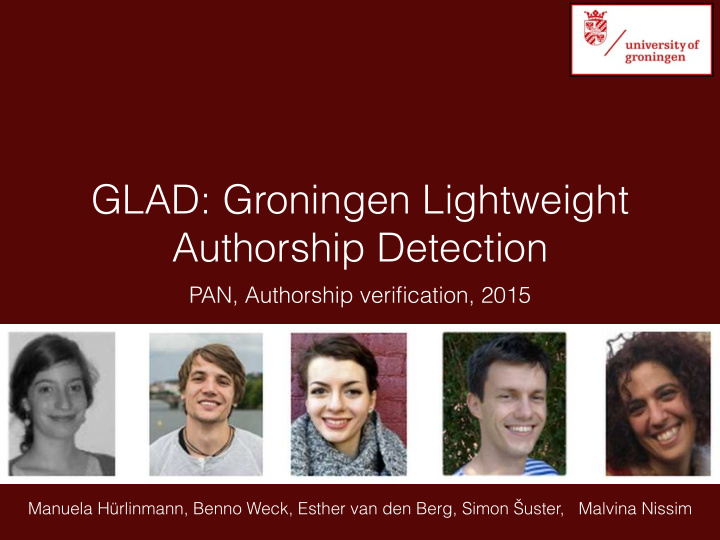



GLAD: Groningen Lightweight Authorship Detection PAN, Authorship verification, 2015 Manuela Hürlinmann, Benno Weck, Esther van den Berg, Simon Š uster, Malvina Nissim
The challenge given: a set of Known documents written by the same Author A_K , given: one Unknown document written by an unknown Author A_U, task: determine whether A_U = A_K
How can we recognise different authors?
How can we recognise different authors? Unusual word choice? Shorter sentences? More complex grammar?
How can we recognise different authors? individual_vector(feat1, feat2…) individual_vector(feat1, feat2…) individual_vector(feat1, feat2…)
How can we then differentiate between authors?
How can we then differentiate between authors? Different word choice? Different sentence length? Different grammar?
How can we then differentiate between authors? similarity_vector(feat1, feat2, …)
Our approach • machine learning approach training on PAN (2015) data • using SVM to do two-class classification task • a set of features • feature ablation studies to tune the system to each different language
The core aim - A lightweight system!
The aim Input in training training training any instance instance instance language
The aim Input in training training training any instance instance instance language Features should be easy to extract model
The aim Input in training training training any instance instance instance language Features should be easy to extract model Training & Testing time should be fast prediction
Our features
Our features similarity_vector(entropy_of_known, visual_features, …)
Our features To determine relevance: grouping
Our features Individual Individual Joint - = Vector_K(feat1,feat2) Vector_U(feat1,feat2) Vector_Joint(feat1,feat2)
Comparing features
Comparing features Results of ablation & single-feature experiments: Helpful features
Side note: • Punctuation Visual features • Line ending • Letter case • Ling length • Block size
Side note: • Punctuation Visual features • Line ending • Letter case • Ling length • Block size Con Not a • characteristic of the author Not a • linguistic feature
Side note: • Punctuation Visual features • Line ending • Letter case • Ling length • Block size Pro Con Not a • Can be • characteristic author- “Pa-pa, pa-pa, pa-pa! of the author specific for Not a • some genres Here, stop her. She’ll fall down. linguistic If it works… • Here, turn around. Walk this way. feature Ma-ma, ma-ma, ma-ma; Oh, I think you are a darling. Mer-ry Christ-mas! Mer-ry Christmas.”
Comparing features Results of ablation & single-feature experiments: Harmful features
Comparing features Results of ablation & single-feature experiments: Features that are harmful, helpful, or helpful-depending-on-the-language
Comparing features Results of ablation & single-feature experiments: Features that are harmful, helpful, or helpful-depending-on-the-language
Comparing features Results of ablation & single-feature experiments: Differences are subtle
Comparing features Results of ablation & single-feature experiments: Differences are subtle
Resulting groups
Results
Results • Simple similarity features work
Results • Simple similarity features work in unison
Results • Simple similarity features work in unison independent of language (except greek)
Results • Simple similarity features work in unison independent of language (except greek) • System works fast (runtime av. 1 minute)
Final conclusion GLAD … is a light and fast language- independent system … allows language adaptation done via feature selection … involves innovative visual features which appear useful (especially for English data) and could be investigated further
Recommend
More recommend